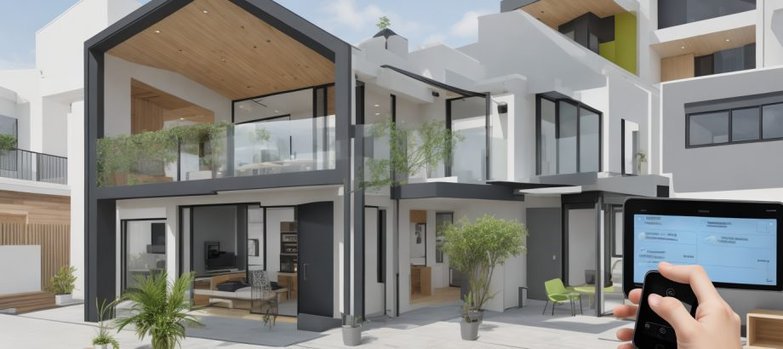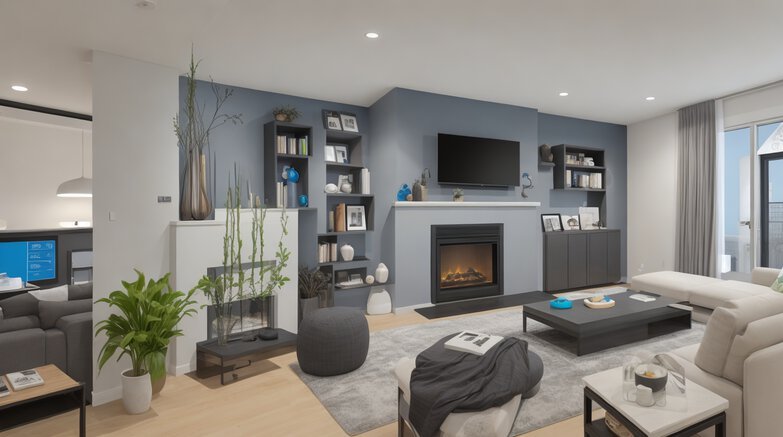What Is a Smart Home

Hey there! Wanna know what a smart home is? Great!
In this awesome article, we’re gonna break down the definition of a smart home, the mind-blowing benefits of smart home technology, and the essential components that bring it all together.
We’ll also delve into how home automation and remote control capabilities amp up your security and safety, while saving you some serious cash through energy efficiency.
And hey, we can’t forget about the cutting-edge trends and advancements in smart home tech.
So, let’s get ready to dive headfirst into the incredible world of smart homes, my friend!
Interior painters in Houston →
Key Takeaways
- A smart home integrates devices and systems through advanced technology, utilizing the Internet of Things (IoT) for connectivity and control.
- The goal of a smart home is to provide convenience, automation, security, and energy efficiency, giving complete control over the home environment.
- Smart home technology offers improved convenience, effortless management of tasks, increased comfort with personalized adjustments, and enhanced accessibility for all household members.
- Key components of a smart home include home automation for remote control of devices and systems, integration of smart security cameras, sensors, and locks, energy efficiency through smart thermostats and lighting, and a focus on convenience, security, and sustainability.
Definition of What is a Smart Home
To understand what a smart home is, you must first grasp the concept of integrating various devices and systems through advanced technology. A smart home is a residence that utilizes the Internet of Things (IoT) to connect and control various smart home features.
These features include voice control, where you can use your voice to command and operate different devices in your home. Home integration is a key aspect of a smart home, as it allows for seamless communication and coordination between different devices and systems.
The main goal of a smart home is to provide convenience and comfort for the homeowners, by automating tasks, enhancing security, and improving energy efficiency. With a smart home, you can have complete control over your home environment, making your life easier and more enjoyable.
Benefits of Smart Home Technology
Experience the countless benefits of smart home technology. It revolutionizes the way you interact with and control your living space.
With improved convenience, you can effortlessly manage various tasks and systems in your home. Just a few taps on your smartphone or voice commands are all it takes.
Enjoy increased comfort as your smart home adapts to your preferences. It can adjust lighting, temperature, and even music to create the perfect ambiance.
Enhanced accessibility ensures that everyone in your household can easily navigate and control the home environment. This includes people of all ages and physical abilities.
Stay connected and secure with remote monitoring. You can check on your house from anywhere and receive alerts for potential issues.
Lastly, the integration with other devices allows for seamless connectivity and control of multiple smart devices. This makes your life simpler and more efficient.
Key Components of a Smart Home
You can start building your smart home by incorporating key components that will enhance your living experience. Home automation is at the heart of a smart home, allowing you to control various devices and systems remotely. With just a tap on your smartphone, you can adjust the temperature, turn on/off lights, and even lock/unlock doors. Security and safety are also crucial aspects of a smart home. Install smart security cameras, door/window sensors, and a smart lock to keep your home safe and secure. Additionally, energy efficiency can be achieved by integrating smart thermostats, smart lighting, and energy monitoring systems. By doing so, you can save energy and reduce your carbon footprint while enjoying the convenience and comfort of a smart home.
| Key Components | Description |
|---|---|
| Home Automation | Control devices and systems remotely |
| Remote Control | Adjust temperature, lights, and locks using your smartphone |
| Security and Safety | Install smart cameras, sensors, and locks for enhanced security |
| Energy Efficiency | Integrate smart thermostats, lighting, and energy monitoring systems |
Home Automation and Remote Control Capabilities
Now, let’s delve into the exciting world of home automation and discover how you can control your smart devices and systems remotely. With the advancement of technology, home automation has become more accessible and convenient. Here are some key features that make it possible:
- Home security: Keep your home safe with smart security systems that allow you to monitor your property from anywhere.
- Voice control: Control your smart devices using voice commands, making it easier to manage your home.
- Smart appliances: Connect your appliances to your smart home system for increased efficiency and convenience.
- Home monitoring: Stay informed about what’s happening in your home with real-time monitoring and alerts.
- Connected devices: Seamlessly integrate all your smart devices into one system for easy control and management.
With these capabilities, you can enjoy the convenience and peace of mind that a smart home offers.
Enhancing Security and Safety With Smart Home Devices
Enhance the security and safety of your smart home with the use of advanced smart home devices.
Smart locks, surveillance cameras, motion sensors, fire detection, and emergency alerts are essential components that can protect your home and loved ones.
Smart locks provide enhanced security by allowing you to control access to your home remotely.
You can monitor your surroundings with surveillance cameras that offer real-time video feeds accessible through your smartphone.
Motion sensors detect any movement within your property, triggering alarms or sending notifications to your device.
Fire detection systems can alert you in case of smoke or fire, enabling a faster response to prevent further damage.
Emergency alerts keep you informed about potential threats or emergencies, ensuring that you can take immediate action to protect your home and family.
With these advanced smart home devices, you can enjoy peace of mind knowing that your security and safety are enhanced.
Energy Efficiency and Cost Savings in Smart Homes
Maximizing energy efficiency and reducing costs is a key benefit of incorporating smart home technology.
With energy monitoring, you can track your energy consumption and identify areas for improvement.
Appliance automation allows you to schedule when your devices turn on and off, ensuring they aren’t left running unnecessarily.
Lighting control enables you to adjust the brightness and color of your lights, saving energy while creating the perfect ambiance.
Temperature regulation allows you to set the ideal temperature for each room, optimizing comfort and reducing energy waste.
With automated savings, your smart home system can analyze your energy usage patterns and make adjustments to maximize efficiency, ultimately saving you money on your utility bills.

Future Trends and Advancements in Smart Home Technology
To further improve your smart home experience, explore the exciting future trends and advancements in smart home technology.
Voice assistants and smart home integration are becoming more sophisticated, allowing you to control various aspects of your home simply by speaking commands.
The Internet of Things (IoT) continues to expand, enabling seamless connectivity between devices and appliances in your smart home.
Artificial intelligence and machine learning are being integrated into smart homes, allowing for personalized and adaptive automation.
Smart home entertainment and media systems are evolving, providing immersive experiences with high-quality audio and video.
Furthermore, health and wellness applications in smart homes are gaining popularity, with features such as smart thermostats that optimize indoor air quality and smart fitness devices that track your workout progress.
These advancements promise to make your smart home even more convenient, efficient, and enjoyable.
Frequently Asked Questions
Are Smart Homes Only for Wealthy Individuals or Can Anyone Benefit From Them?
Anyone can benefit from smart homes, not just the wealthy. Smart home technology can be cost-effective, making it accessible to all. It also offers features that enhance accessibility for individuals with disabilities, promotes energy efficiency, improves home security, and has a positive impact on the environment.
Can I Still Control My Smart Home Devices if I Don’t Have an Internet Connection?
Yes, you can still control your smart home devices without an internet connection. There are alternative control methods and offline functionality options available. However, remote access and compatibility with different devices may have limitations without internet connection.
What Are the Potential Privacy Concerns of Having a Smart Home?
When it comes to privacy concerns in a smart home, you need to consider data security, personal information, surveillance, and hacking risks. Protect yourself by staying informed and taking necessary precautions.
How Do Smart Homes Integrate With Other Existing Home Systems, Such as Heating and Cooling?
Smart homes integrate with existing home systems like heating and cooling, but there can be integration challenges. However, the benefits include energy efficiency, remote access, cost savings, and security considerations.
Are There Any Health Risks Associated With Living in a Smart Home Due to Increased Exposure to Electromagnetic Fields?
Living in a smart home may increase your exposure to electromagnetic fields, which could potentially pose health risks. These fields are generated by the various devices and technologies used in smart homes.
